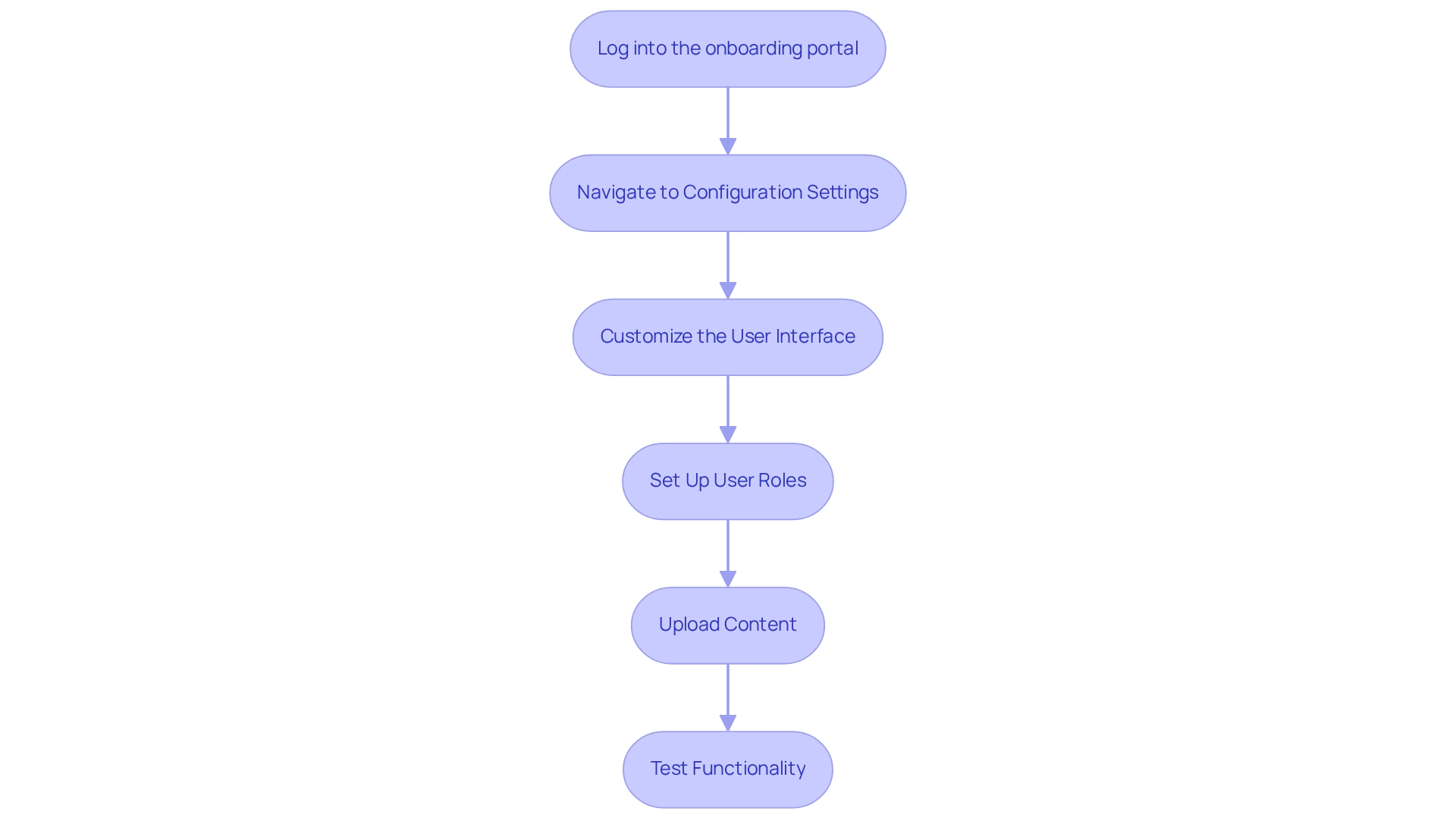
Streamlined Onboarding Processes
|
October 16, 2025
|
4 Steps to Optimize Your Onboarding Portal Setup
Overview
You might be wondering how to set up an onboarding portal that really works. Well, here’s the scoop: there are four essential steps to get you started!
- Define your objectives. What do you hope to achieve with your onboarding process?
- Gather your resources. This is all about collecting the tools and materials you’ll need to make it happen.
- Identify your stakeholders—who’s involved in this process?
- Select the right software tools.
These steps are crucial because they help create a structured and user-friendly onboarding experience. This not only enhances new employee integration but also boosts retention rates. Plus, there’s solid evidence that a well-organized orientation can significantly increase employee satisfaction and reduce turnover.
So, are you ready to dive in and make your onboarding process shine?
Key Highlights:
- Define clear objectives for the onboarding portal to enhance new employee integration and retention.
- Compile essential resources, including training documents and multimedia content, to support the onboarding process.
- Identify stakeholders involved in the onboarding process to ensure cohesive collaboration.
- Choose a user-friendly software platform with customization options to fit company branding.
- Create a structured timeline with milestones for the onboarding process to maintain focus and meet goals.
- Test the onboarding portal for functionality to ensure a smooth user experience before launch.
- Gather feedback from new employees post-orientation to identify strengths and areas for improvement.
- Monitor engagement metrics to assess the effectiveness of the onboarding portal and materials.
- Regularly update onboarding content to reflect changes in company policies and procedures.
- Provide ongoing support, including mentorship and diversity training, to enhance the onboarding experience.
- Evaluate the onboarding process periodically to make informed improvements based on feedback and engagement.
Introduction
You might be wondering how the onboarding experience can really shape an employee's journey within your organization. Well, in today’s competitive talent acquisition landscape, it’s a game changer! A well-structured onboarding portal does more than just integrate new hires; it boosts their engagement and retention right from day one. By setting clear objectives, gathering essential resources, and using the right tools, you can create a welcoming environment that encourages productivity and satisfaction.
Now, let’s dive into the critical steps for setting up your onboarding portal. We’ll cover everything from the initial configuration to ongoing support, all while highlighting the importance of continuous improvement and feedback. After all, cultivating a thriving workplace culture is a journey, not a destination!
Prepare for Onboarding Portal Setup
- Define Your Objectives: So, what are the goals of your onboarding portal? It’s important to think about what new employees really need to grasp and the procedures they should follow. Jotting these goals down is crucial for guiding the integration process, especially since those first few weeks are key for motivating and retaining new hires.
- Gather Necessary Resources: Now, let’s talk about compiling all the must-have materials for the integration phase. This includes training documents, company policies, and even multimedia content like videos and presentations. A well-rounded resource pool can really enhance the learning experience.
- Identify Stakeholders: Who’s involved in this integration journey? Recognizing all parties, like HR personnel, team leaders, and IT support, is essential. When everyone is on the same page with the integration goals, it fosters a more cohesive approach.
- Choose the Right Tools: Next up, you’ll want to select a software platform for your orientation portal. Look for customization options, user-friendliness, and how well it integrates with existing systems. Consider using a suite of Slack HR plugins to manage PTO, kudos, referrals, and org charts—these can really boost team workflows and connections.
- Create a Timeline: Now, let’s get organized! Developing a structured schedule for the induction, with clear milestones and deadlines for each setup stage, helps keep everyone focused and ensures that integration goals are met on time.
Recent trends show that having organized orientation procedures can significantly boost employee retention. Did you know that organizations prioritizing culture from the get-go report a whopping 91% higher first-year retention rate? This really highlights the importance of setting clear integration objectives. Plus, incorporating organized check-ins, guidance, and career development planning is vital for long-term integration success. By following these best practices, organizations can create that not only facilitates new employee integration but also enhances long-term staff engagement and satisfaction.
Configure the Onboarding Portal
- Log into the onboarding portal: First things first, let’s get you logged into the onboarding portal using your admin credentials. This step is crucial to ensure you have the right permissions.
- Navigate to Configuration Settings: Now, find the settings menu—it’s usually hanging out in the dashboard or admin panel. This is where you can tweak various aspects of the onboarding portal to meet your needs.
- Customize the User Interface: You might be wondering how to make this portal truly yours. Tailor the layout, colors, and branding to match your company’s vibe. Don’t forget to incorporate your logo and pick a color scheme that feels cohesive and welcoming for new hires. A customized user interface can really enhance the experience on the onboarding portal!
- Set Up User Roles: Next up, let’s talk about user roles. It’s important to clearly define who gets access to what. Decide who can view specific information and who has the power to edit content within the onboarding portal. This ensures a secure and organized structure.
- Upload Content: Ready to share some knowledge? Start uploading all those training materials and resources you’ve gathered into the onboarding portal. Organize them into categories for easy navigation—this will really enhance . With SowFlow's instant documentation solution, you can create and update user guides effortlessly, keeping your training resources fresh and effective. Remember, effective induction is key to long-term retention; in fact, 83% of employees say a structured orientation program is a game changer!
- Test Functionality: Before you go live, let’s do a thorough test run of the portal. Check that all links are working, content is accessible, and the overall user experience is smooth sailing. This step is vital because the onboarding portal can utilize automated integration to reduce mistakes in employee information gathering by 73%! By leveraging SowFlow's capabilities, you can simplify standardization and boost knowledge sharing, ultimately enhancing team efficiency.

Export the New Hire Portal
- Access the Export Function: You might be wondering where to start. Just navigate to the portal settings and look for the export option, which is usually tucked away under the configuration or tools menu.
- Select Export Format: Next up, choose the export format that suits your needs—be it CSV, PDF, or something custom. It all depends on how you plan to share this information.
- Choose Content to Export: Now, let’s get specific. Identify and select the content you want to export. This could include training documents, checklists, or multimedia resources. Make sure your selection aligns with what new employees need for a smooth onboarding portal experience.
- Initiate the Export: Ready to go? Click that export button and let the magic happen. Don’t forget to save the exported file in a secure spot to keep everything confidential yet accessible.
- Distribute to New Employees: Finally, it’s time to share! Send those exported materials to new employees via email or a secure file-sharing platform. Ensure they have everything they need before their start date. After all, a solid integration process through can really boost employee engagement and help reduce turnover. Did you know that only 29% of new employees feel fully supported after orientation? With the average job tenure being under 4 years, it’s clear that a systematic induction is key. Plus, consider tools like SowFlow, which offers a free trial and a range of services to enhance this process. As Anastasia Masadi, a Product Owner, put it, "SowFlow has been a game changer in the way we document work and deliver to our clients." This tool allows teams to whip up SOPs and training materials instantly, right from the browser. That’s efficiency at its best! And let’s not forget, 67% of companies report over a 10% drop-off rate before new hires even join, highlighting the challenges organizations face during integration. By fostering collaboration among HR, team leaders, and IT, companies can really enhance the orientation experience.
Next Steps After Setup
Gathering feedback is essential! After new employees explore the onboarding portal, why not ask for their thoughts? You can do this through organized surveys or even casual check-ins. This not only helps spot strengths and weaknesses in the introduction experience but also fosters a culture of open communication. Did you know that 83% of employees believe a well-defined induction program really helps them integrate into the company? That just shows how valuable a structured introduction can be!
Now, let’s talk about monitoring engagement. Regularly tracking how new hires engage with the onboarding portal is key. Take note of how often they access it and which resources they find most useful. This info is crucial for pinpointing areas that might need a little TLC, ensuring the introduction experience is both effective and engaging. Recent findings reveal that employees who complete all aspects of effective orientation tend to score higher on performance reviews within six months. That really underscores the importance of a comprehensive training process!
Updating content regularly is another must. To keep everything relevant, it’s important to routinely review and refresh all introductory materials. This means integrating any changes in company policies or procedures, which helps keep new employees informed and aligned with what’s expected. Continuous training practices are trending, highlighting the importance of ongoing content relevance in today’s fast-paced business world.
And don’t forget about providing ongoing support! Establishing a solid support system for new hires—like mentorship programs or regular check-ins with HR—can really make a difference. This approach helps address any questions or concerns they might have, making their transition into their roles smoother. Plus, incorporating diversity and inclusion training into orientation is becoming increasingly vital. In fact, 55% of firms are including such training as part of , which can significantly enhance the workplace environment and boost employee satisfaction.
Finally, evaluating the induction system is crucial. Periodically assessing how effective the onboarding portal and the overall induction process are can lead to valuable insights. By utilizing feedback and engagement metrics, you can make informed adjustments and improvements. This ongoing evaluation ensures that the integration experience evolves alongside the organization and effectively meets the needs of new employees.
To further enhance your integration experience, why not reach out to SowFlow? They offer innovative solutions that can revolutionize documentation and knowledge management. With their instant user guides and user-friendly tools—like streamlined documentation and real-time updates—you can optimize every step of , ensuring a seamless workflow capture.
Conclusion
Creating an effective onboarding portal isn’t just a task; it’s a strategic investment in your organization’s future. You might be wondering how to get started. Well, by defining clear objectives, gathering essential resources, and identifying key stakeholders, you can lay a solid foundation for new hires. Customizing the portal and ensuring it’s user-friendly are critical steps that enhance the overall experience, making new employees feel welcomed and supported right from the start.
Now, let’s talk about the importance of ongoing support and regular feedback. It can’t be overstated! Monitoring engagement and updating content regularly ensures that the onboarding process remains relevant and effective. By actively seeking input from new hires, you can continuously improve your onboarding strategies, fostering a culture of open communication and inclusion.
Ultimately, a well-structured onboarding portal not only facilitates a smoother transition for new employees but also significantly contributes to higher retention rates and overall job satisfaction. Investing time and resources into this process is essential for cultivating a thriving workplace culture that benefits both your organization and its employees in the long run. So, why not prioritize onboarding as a critical component of talent management? It will undoubtedly pay dividends in building a cohesive and engaged workforce.
Frequently Asked Questions
What are the first steps in creating an onboarding portal?
The first steps include defining your objectives, gathering necessary resources, identifying stakeholders, choosing the right tools, and creating a timeline.
Why is it important to define objectives for the onboarding portal?
Defining objectives is crucial for guiding the integration process and ensuring new employees understand what they need to grasp and the procedures they should follow, which helps in motivating and retaining them.
What types of resources should be gathered for the onboarding process?
Necessary resources include training documents, company policies, and multimedia content such as videos and presentations to enhance the learning experience.
Who are considered stakeholders in the onboarding process?
Stakeholders include HR personnel, team leaders, and IT support, as their involvement is essential for a cohesive approach to integration.
What factors should be considered when choosing tools for the onboarding portal?
When selecting a software platform, consider customization options, user-friendliness, and how well it integrates with existing systems. Utilizing tools like Slack HR plugins can also enhance team workflows.
How can a timeline benefit the onboarding process?
A structured timeline with clear milestones and deadlines helps keep everyone focused and ensures that integration goals are met on time.
What impact does organized orientation have on employee retention?
Organized orientation procedures can significantly boost employee retention, with organizations prioritizing culture reporting a 91% higher first-year retention rate.
What additional practices can enhance long-term integration success?
Incorporating organized check-ins, guidance, and career development planning is vital for ensuring long-term integration success for new employees.
👍
What others are liking
5 Steps to outline your ideal documentation structure
5 MINS READ
Where to start the your journey of mapping out your ideal documentation structure, aligning it with the very heartbeat of your organization?
Defining a winning level of detail in your process
3 MINS READ
What is too much detail, and what is too little? This article described in that winning level detail about what detail is enough.





